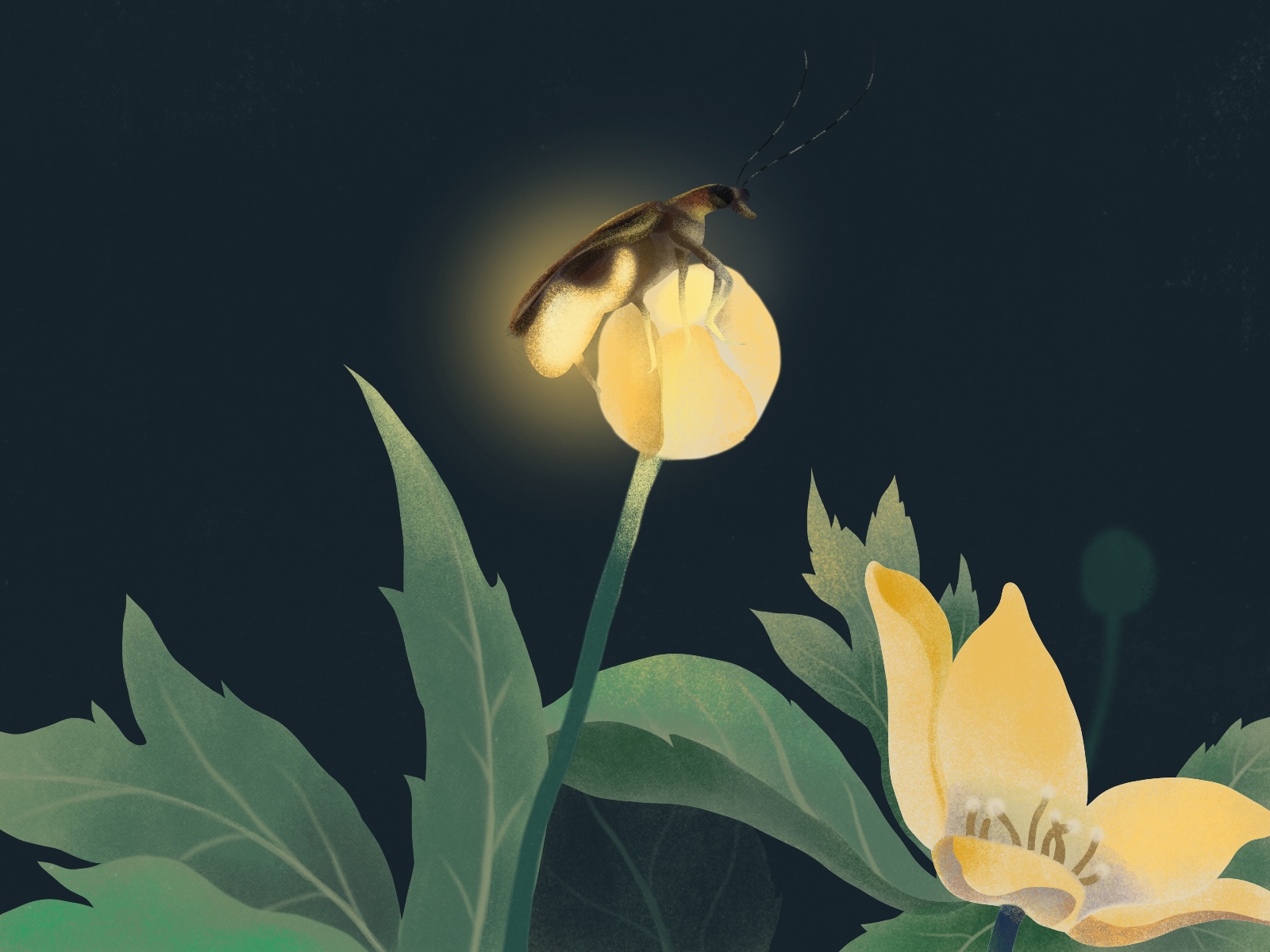Best of The Haiku Challenge (June 2024)
Announcing the winning poems from Tricycle’s monthly challenge The post Best of The Haiku Challenge (June 2024) appeared first on Tricycle: The Buddhist Review.

Announcing the winning poems from Tricycle’s monthly challenge
By Clark Strand Aug 03, 2024 Illustration by Jing Li
Illustration by Jing LiAlthough they are lovely to watch on summer evenings, fireflies have often been associated with melancholy in haiku—either because they evoke feelings of nostalgia for lost childhood or because their intermittent light has the paradoxical effect of making the dark feel even darker. Fireflies are always blinking—and always being swallowed by the night. The winning and honorable mention poems for last month’s challenge all struck a balance between beauty and sadness, using the season word to express something of a personal nature about human life.
Marie Derley takes refuge in the silent beauty of “a few fireflies” flickering in the distance as her companion drones on and on. Suzanne Tyrpak bids farewell to the last female firefly of the season—or maybe ever—“with no one to signal back.” Jesus Santos visits a graveyard for a nighttime vigil where the fireflies pass their lights “like candles one to another.”Congratulations to all! To read additional poems of merit from recent months, visit our Tricycle Haiku Challenge group on Facebook.
You can submit a haiku for the current challenge here.
WINNER:
his explanations
far away the tiny light
of a few fireflies
—Marie Derley
The term “mansplaining” first emerged on feminist blogs in response to Rebecca Solnit’s 2008 essay “Men Explain Things to Me,” in which she reported meeting a man at a party who interrupted her description of a book she had recently written to explain that very book to her—without realizing that she was its author.
A few years later, Solnit expressed reservations about the word that, by then, had already made its way into some dictionaries: “[I]t seems to me to go a little heavy on the idea that men are inherently flawed this way, rather than that some men explain things they shouldn’t and don’t hear things they should.” To be fair, Solnit made that point in her original essay. But the term described the experience of so many women that, gendered or not, it stuck.
The poet is anything but heavy-handed in her nod to mansplaining in last month’s winning haiku. The allusion becomes clear only when her companion’s “explanations” are juxtaposed with the image of fireflies blinking noiselessly in the distance.
Is she bored? Or are the fireflies meant to express the retreat into silence one experiences when a conversation becomes one-sided, the stream of words blending together until they become almost meaningless? Is it easier to assert oneself in such moments … or to become absent?
It seems a deliberate choice by the poet not to answer that question in her haiku. She must be sitting somewhere near her companion. But we don’t know where her mind is, only her eyes.
The message of the poem is found in following her gaze off into the distance. What is expressed by “the tiny light of a few fireflies” blinking silently in the summer dusk as the man goes on and on?
If there is anger, it is muted. What we feel mostly is the mix of loveliness and loneliness. Lost in his head, the man has set the fireflies and the poet both at a remove. But there is nothing in the poem to suggest that he is aware of doing this.
“The intersection between overconfidence and cluelessness” is the way Solnit described mansplaining. That the poet has managed to convey the emotional nuances of that experience in three simple lines is a miracle of subtlety and compression.
HONORABLE MENTIONS:
her light flickering
with no one to signal back
goodbye, last firefly
– Suzanne Tyrpak
fireflies at the graves
their light passed on like candles
one to another
– Jesus Santos
♦
You can find more on May’s season word, as well as relevant haiku tips, in last month’s challenge below:
Summer season word: “Firefly”
if others see it
is it still an inner light
you tell me, firefly
Submit as many haiku as you wish that include the season word “firefly.” Your poems must be written in three lines of 5, 7, and 5 syllables, respectively, and should focus on a single moment of time happening now.
Be straightforward in your description and try to limit your subject matter. Haiku are nearly always better when they don’t have too many ideas or images. So make your focus the season word* and try to stay close to that.
*REMEMBER: To qualify for the challenge, your haiku must be written in 5-7-5 syllables and include the word “firefly.”
Haiku Tip: Master the Art of Greeting!
The Japanese haiku master Takahama Kyoshi (1884-1959) felt that the true purpose of haiku was son-mon, or “greeting.” According to his granddaughter, Teiko Inabata, Kyoshi believed that “haiku poets can have son-mon with any being in nature—from pebbles to mountains, rivers, clouds in the sky.”
In early haiku, “greeting” was a formal convention that meant acknowledging some aspect of the season in every poem. With Kyoshi it became an animistic approach to the natural world that was almost a religion in itself.
According to Inabata, Kyoshi recited the motto Kacho fuei (“formal composition on birds and flowers”) as if it were the name of Amida Buddha and regarded his heart as a place to converse with all living and non-living things. “Through repeating son-mon, he realized that there is no difference between his life and the lives of birds and flowers.”
In practice, the “Art of Greeting” means experiencing the subjects of our poems as living beings. Whether they are animate or inanimate to a conventional way of thinking matters not at all. The whole universe is alive for the haiku poet. Everything in it is a “who” not a “what.”
A note on fireflies: Roughly 2,000 beetles belong to the Lampyridae (“marsh fire”) family. Although some species do not emit light as adults, all glow as larvae. Fireflies live in temperate to tropical climates and are partial to bogs or damp wooded areas. Bioluminescence plays a role in sexual selection, with females flashing synchronously from the ground in response to the flash of a specific male. Firefly populations are in decline worldwide as a result of habitat loss, pollution, pesticide use, and climate change. Nevertheless, “firefly festivals” remain popular in many countries—especially in Japan, where special parks are set aside for that purpose.
![]()
Thank you for subscribing to Tricycle! As a nonprofit, we depend on readers like you to keep Buddhist teachings and practices widely available.

 MikeTyes
MikeTyes 





















![Run An Ecommerce SEO Audit in 4 Stages [+ Free Workbook]](https://api.backlinko.com/app/uploads/2025/06/ecommerce-seo-audit-featured-image.png)









